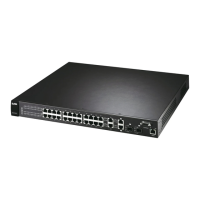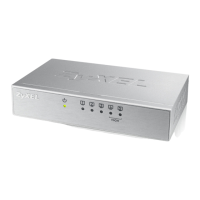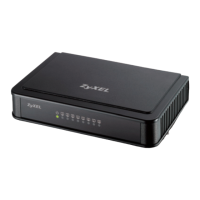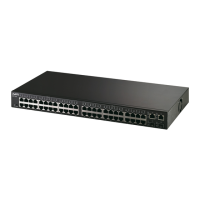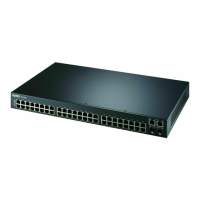Hardware Overview Page: 41 Panel Connections Details the front panel layout and describes the function of each connector and port.
Console Port Explains console port connection and configuration for local management via terminal emulation.
Ethernet Ports Describes 10/100Mbps auto-negotiating ports and Dual Personality Gigabit/mini-GBIC interfaces.
Mini-GBIC Slots Describes the slots for mini-GBIC transceivers and their connection requirements.
Rear Panel Shows rear panels for AC/DC models, including BPS connector and power receptacle.
Power Connector Instructions on connecting the correct power source for both AC and DC units.
LEDs Describes the function and status of various LEDs for system and port status indication.
Basic Setting Page: 69 Overview Explains System Info, General Setup, Switch Setup, and IP Setup screens.
General Setup Configures general settings like system name, time, and location.
Switch Setup Screen Sets global switch parameters like VLAN type, MAC learning, and priority queues.
IP Interfaces Explains IP interfaces (routing domains) for management and inter-subnet routing.
Port Setup Guides on configuring switch port settings, including speed, duplex, and BPDU control.
VLAN Page: 81 GARP Defines GARP as a protocol for registering attribute values within a bridged LAN.
GARP Timers Explains GARP timers set declaration timeout values for switches joining VLANs.
GVRP Defines GVRP as a protocol for registering necessary VLAN members on network ports.
Port VLAN Trunking Enables VLAN Trunking to allow frames from unknown VLAN groups to pass through ports.
Static VLAN Decides frame forwarding based on VLAN tags or port membership.
Port-based VLAN Setup Explains port-based VLANs where forwarding decisions are based on MAC address and port.
Multicast Page: 159 Multicast Overview Explains packet transmission (Unicast, Broadcast) and introduces Multicast.
IGMP Filtering Controls which IGMP groups subscribers can join based on service plans.
IGMP Snooping Learns IP multicast group membership passively, reducing manual configuration.
MVR Overview Introduces MVR for sharing a single multicast VLAN among subscriber VLANs.
Types of MVR Ports Defines MVR source and receiver ports and how the switch maintains a forwarding table.
MVR Modes Explains the dynamic and compatible modes for operating MVR.
How MVR Works Illustrates MVR operation with a multicast television example.
Access Control Page: 223 About SNMP Explains SNMP for managing and monitoring TCP/IP devices using agents and managers.
Configuring SNMP Guides on configuring SNMP settings, including community strings and trap destinations.
SSH Overview Introduces SSH as a secure protocol for encrypted communication.
How SSH works Summarizes secure connection establishment: host identification, encryption, authentication.
Introduction to HTTPS Defines HTTPS as a web protocol for secure transactions using SSL, certificates, and keys.
HTTPS Example Shows how to access the switch securely using HTTPS and browser warnings.
Remote Management Guides on specifying trusted computers for administrator access to switch services.
Introducing Commands Page: 259 Overview Explains using commands for switch configuration, diagnosis, and troubleshooting.
Accessing the CLI Guides on accessing the command interpreter via console connection or Telnet.
The Console Port Details connecting to the console port using terminal emulation software with specific settings.
The Login Screen Describes the login screen for console or Telnet connections, with default credentials.
Privilege Levels Describes using commands based on privilege levels and obtaining them via VSA for RADIUS users.
Command Modes Details the three command modes: User, Enable, and Configure, and how to access them.
Getting Help Explains the system's help facility for listing commands and their detailed descriptions.
Logging Out Explains how to exit the CLI from User, Enable, or Config modes.
Command Summary Summarizes available commands with descriptions, organized by mode.
User Mode Lists commands available in User mode for basic tests and system information.
Enable Mode Lists commands in Enable mode for configuration settings and system information.
config-vlan Commands Lists vlan commands in configuration mode for creating and configuring VLAN groups.
mvr Commands Lists mvr commands in configuration mode for creating and configuring multicast VLANs.
User and Enable Mode Commands Page: 299 Overview Provides command examples for using User and Enable modes to diagnose and manage the switch.
show Commands Lists commonly used 'show' commands for displaying switch information.
show ip Describes the command to display IP related information for all switch interfaces.
show logging Explains how to display system logs and the consequence of clearing them.
show interface Describes how to display port statistics and related information.
ping Explains the ping command for sending packets to Ethernet devices and displaying replies.
traceroute Describes the traceroute command for displaying route information to Ethernet devices.
Copy Port Attributes Guides on using the 'copy running-config' command to copy port attributes to other ports.
Configuration Mode Commands Page: 307 Configure IGMP Filter Guides on configuring IGMP filtering profiles to control access to multicast groups.
Enabling STP Explains using 'spanning-tree' or 'mrstp' commands to enable and configure STP and MRSTP.
no Command Examples Provides examples of 'no' commands used to disable, reset, or re-enable features.
Disable Commands Shows how to use the 'no' command to disable features like STP and port mirroring.
Resetting Commands Demonstrates using 'no' commands to reset settings to default values, like HTTPS timeout.
Re-enable commands Shows how the 'no' command can be used to re-enable previously disabled features.
no trunk Shows examples of disabling trunk groups, LACP, or removing ports from trunks.
no ssh Shows examples of disabling SSH encryption keys and removing remote hosts.
Enabling MAC Filtering Explains creating MAC filters to drop packets based on source or destination MAC address.
Enabling Trunking Guides on creating and enabling trunks, placing ports in trunks, and enabling LACP.
Interface Commands Page: 321 Overview Explains that interface commands allow switch configuration on a port-by-port basis.
bpdu-control Explains setting how Bridge Protocol Data Units (BPDUs) are used in STP port states.
broadcast-limit Guides on enabling broadcast storm control limits and setting packet rates per second.
bandwidth-limit Explains enabling bandwidth control on the switch for ingress and egress limits.
mirror Explains enabling port mirroring for incoming, outgoing, or both traffic.
gvrp Explains enabling GVRP for propagating VLAN information beyond the local switch.
ingress-check Enables discarding incoming frames for VLANs not in the port's member set.
frame-type Explains accepting tagged, untagged, or all Ethernet frames on a port.
weight Explains setting interface WFQ weighting values for queues.
egress set Explains setting the outgoing traffic port list for a port-based VLAN.
qos priority Explains setting the quality of service priority for ports using IEEE 802.1p.
name Explains setting a name for port interfaces.
speed-duplex Guides on setting duplex mode and speed (10/100/1000 Mbps) for interfaces.
test Explains performing interface loopback tests on specified ports.
no bandwidth-limit Shows disabling bandwidth limits on a port using the 'no bandwidth-limit' command.
IEEE 802.1 Q Tagged VLAN Commands Page: 329 Configuring Tagged VLAN Guides on configuring tagged VLANs using 'vlan', 'interface port-channel', and 'pvid' commands.
GARP Status Shows how to display the switch's GARP timer settings.
GARP Timer Explains setting switch GARP timer values for join, leave, and leave all actions.
GVRP Timer Shows how to display the switch's GVRP settings.
Enable GVRP Explains turning on GVRP to propagate VLAN information beyond the local switch.
Disable GVRP Explains turning off GVRP to prevent VLAN information propagation.
Port VLAN Commands Guides on configuring switch port VLAN settings in config-interface mode.
Set Port VID Explains setting the default VLAN ID on ports using the PVID command.
Modify Static VLAN Guides on configuring the static VLAN table using commands in config-vlan mode.
Tagged Frames Details the first steps in the forwarding process for tagged frames.
Untagged Frames Describes the process for handling untagged frames, including PVID assignment.
Delete VLAN ID Explains deleting a specified VLAN ID entry from the static VLAN table.
Enable VLAN Describes enabling a specified VLAN ID in the SVLAN (Static VLAN) table.
Disable VLAN Explains disabling a specified VLAN ID in the SVLAN table using 'vlan <vlan-id> inactive'.
Show VLAN Setting Shows how to display the IEEE 802.1Q Tagged SVLAN table, including VID and status.
Product Specifications Page: 349 IP Routing Domain An IP interface not bound to a physical port, used to route traffic between networks.
VLAN Allows partitioning physical networks into logical ones, restricting traffic between groups.
VLAN Stacking Adds outer VLAN tags to inner tagged frames for managing multiple customer VLANs.
IGMP Snooping Enables IGMP snooping for forwarding multicast traffic only to group members.
Queuing Solves performance degradation using SPQ, WRR, and WFQ for packets from individual sources.
Port Mirroring Copies traffic from ports to a monitor port for examination without interference.
Static Route Tells the switch how to forward IP traffic when TCP/IP parameters are configured manually.
IP Multicast Delivers IP packets to a group of hosts, supporting untagging for VLAN-unaware devices.
RIP Allows routing devices to exchange routing information with other routers.
OSPF A link-state protocol for distributing routing information within autonomous systems.
DVMRP Routes multicast data within autonomous systems using RPM and IGMP.
VRRP Creates redundant backup gateways to ensure default gateway availability.
Link Aggregation Groups physical ports into one logical higher-capacity link for increased bandwidth.
Firmware Upgrade Download and upload new firmware using web configurator, CLI, or FTP/TFTP.
Cluster Management Manages switches through a cluster manager, requiring direct connection and same VLAN group.
Interface Lists port types, connectors, auto-negotiation, and flow control features.
Layer 2 Features Covers Bridging, Switching fabric, MAC addresses, broadcast storm control, and STP.
Layer 3 Features Includes IP capability, routing protocols (RIP, OSPF, DVMRP, VRRP), and IP services.
Security Details IEEE 802.1x authentication, MAC address filtering, and dynamic address limits.
System Control Covers alarm/status surveillance, LED indicators, performance monitoring, and line speed.
MIB Lists supported MIBs for collecting statistics and monitoring performance.
LEDs Lists LEDs for main switch, gigabit ports, mini-GBIC ports, and management port.
Dimension Provides the physical dimensions of the switch for rack mounting.
Weight Specifies the weight of the switch.
Temperature Lists operating and storage temperature ranges for the switch.
Humidity Specifies the operating humidity range for the switch.
Power Supply Details AC and DC power supply specifications and consumption.
Safety Lists safety certifications including UL, CSA, EN, and IEC standards.
EMC Lists EMC certifications including FCC and CE.



